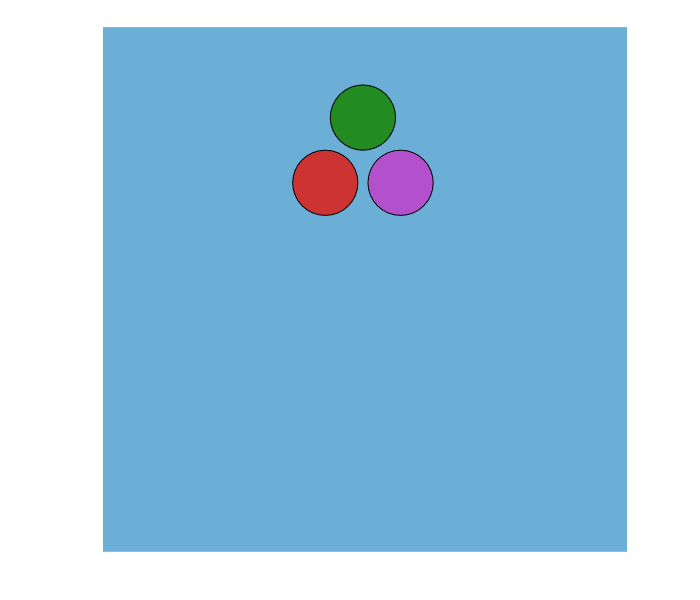WaterLily
Overview
WaterLily is a real-time fluid simulator written in pure Julia. This is an experimental project to take advantage of the active scientific community in Julia to accelerate and enhance fluid simulations. If you want to play around with a much more fully developed and documented solver right now, you should head over to LilyPad.
Method/capabilities
WaterLily solves the unsteady incompressible 2D or 3D Navier-Stokes equations on a Cartesian grid. The pressure Poisson equation is solved with a geometric multigrid method. Solid boundaries are modelled using the Boundary Data Immersion Method (though only the first-order method is currently implemented).
Examples
The user can set the boundary conditions, the initial velocity field, the fluid viscosity (which determines the Reynolds number), and immerse solid obstacles using a signed distance function. These examples and others are found in the examples.
Flow over a circle
We define the size of the simulation domain as n=2^pxm=2^(p-1) cells. The power of two lets the MultiLevelPoisson solver quickly determine the pressure at each time step. The circle has radius R=m/8 and is centered at [m/2,m/2] and this is imposed on the flow using a signed distance function. The flow boundary conditions are [U=1,0] and Reynolds number is Re=UR/ν.
using WaterLily
using LinearAlgebra: norm2
function circle(p=7;Re=250)
# Set physical parameters
n,m = 2^p,2^(p-1)
U,R,center = 1., m/8., [m/2,m/2]
ν=U*R/Re
@show R,ν
# Immerse a circle (change for other shapes)
c = BDIM_coef(n+2,m+2,2) do xy
norm2(xy .- center) - R # signed distance function
end
# Initialize Simulation object
u = zeros(n+2,m+2,2)
a = Flow(u,c,[U,0.],ν=ν)
b = MultiLevelPoisson(c)
Simulation(U,R,a,b)
end
sim = circle();Replace the circle's distance function with any other, and now you have the flow around something else... such as a donut or the Julia logo. Note that the 2D vector fields c,u are defined by 3D arrays such that u[x,y,2]=u₂(x,y) and that the arrays are padded size(u)=size(c)=(n+2,m+2,2).
With the Simulation defined, you simulate the flow up to dimensionless time t_end by calling sim_step!(sim::Simulation,t_end). You can then access and plot whatever variables you like. For example, you could print the velocity at I::CartesianIndex using println(sim.flow.u[I]) or plot the whole pressure field
using Plots
contour(sim.flow.p')A set of flow metric functions have been implemented and the examples showcase a few of these to make gifs, etc.
3D Taylor Green Vortex
You can also simulate a nontrivial initial velocity field by applying a vector function.
function TGV(p=6,Re=1e5)
# Define vortex size, velocity, viscosity
L = 2^p; U = 1; ν = U*L/Re
# Taylor-Green-Vortex initial velocity field
u = apply(L+2,L+2,L+2,3) do i,vx
x,y,z = @. (vx-1.5)*π/L # scaled coordinates
i==1 && return -U*sin(x)*cos(y)*cos(z) # u_x
i==2 && return U*cos(x)*sin(y)*cos(z) # u_y
return 0. # u_z
end
# Initialize simulation
c = ones(L+2,L+2,L+2,3) # no immersed solids
a = Flow(u,c,zeros(3),ν=ν)
b = MultiLevelPoisson(c)
Simulation(U,L,a,b)
endThe velocity field is defined by the vector component i and the 3D position vector vx. We scale the coordinates so the velocity will be zero on the domain boundaries and then check which component is needed and return the correct expression.
Development goals
- Immerse obstacles defined by 3D meshes or 2D lines using GeometryBasics.
- GPU acceleration with CUDA.jl.
- Split multigrid method into its own repository, possibly merging with AlgebraicMultigrid or IterativeSolvers.
- Automatic differentiation with JuliaDiff for optimization and ML.

